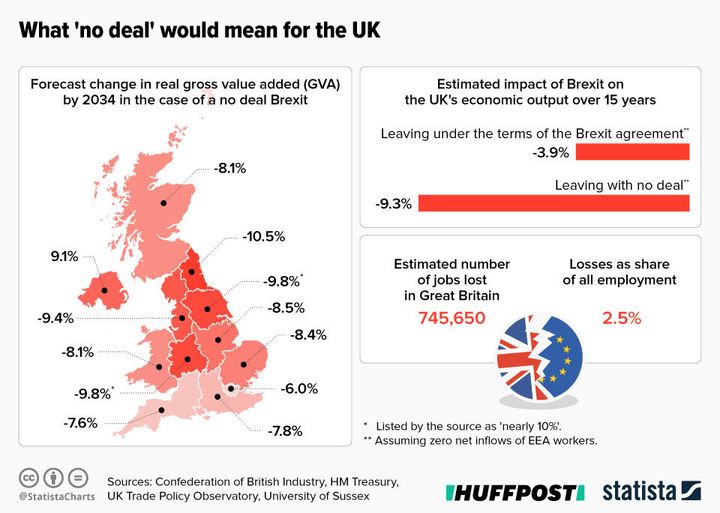March 29, 2019. Brexit Day. Independence Day. Doomsday. Call it what you will. But as we pass the milestone that was meant to be the moment the UK actually left the EU, just how was the date fixed in the first place?
As with most things on Brexit, it’s a combination of legal complexity, political window-dressing and internal Tory politics.
When 17 million people voted to ‘Leave’ in the 2016 referendum, there was no precise Exit Day fixed in anyone’s mind and it barely featured on the campaign trail.
The issue of a timetable soon reared its head within days of Theresa May becoming prime minister, with some of her party wondering when she would start the two-year ‘Article 50’ legal process needed to quit the EU.
Under growing pressure from her backbenchers, May then decided to use the party conference to declare she would trigger the process by “the first quarter of 2017”. The speech won rapturous applause from the Tory faithful.
However, a certain Jacob Rees-Mogg, who was slowly building his profile, warned that unless the PM got a move on, there was a danger that an incoming Labour government could stop the process. Back then, the next general election looked like it would be in 2020 or even earlier.
Then Brexit secretary David Davis counselled May that her ‘first quarter’ timetable was too imprecise, one insider said.
Davis also told her privately that he needed as much time as possible to negotiate the huge divorce deal. As a result, the end of March 2017 was picked for the big moment to start the two-year Article 50 procedure.
No one wanted the new era outside the EU to start on April 1, given the obvious connections to April fool’s day. Officials had also looked at the calendar ahead and spotted that March 30 and 31 were weekend dates, so the Friday March 29 was chosen instead.
It instantly featured in online ‘countdown clocks’, devised by pro-Brexit campaigners and others, which ticked down the minutes and hours to the magic day.

Yet the exact date was not ever intended for British legislation at that stage. It was only once the EU Withdrawal Bill emerged that Brexiteers began to agitate for a precise ‘Exit Date’ to be written into the law.
The real catalyst was the resignation of Priti Patel from Cabinet in early November 2017. A former leading member of the Vote Leave campaign, Patel’s departure over unauthorised contacts in Israel began to unnerve some backbenchers.
May’s Downing Street aides came up with the brainwave of placating the party by writing March 29, 2019 into the Brexit bill. Officials in Davis’s Brexit department felt the idea was a ‘gimmick’ dreamed up by strategy chief Robbie Gibb.
Davis himself felt the move was unnecessary, but No10 got its way and, without Cabinet agreement, an op-ed article by the prime minister was handed to the Daily Telegraph. Neatly drawing a line under the Patel story, the newspaper splashed its front page with the story.
May wrote: “It will be there in black and white on the front page of this historic piece of legislation: the United Kingdom will be leaving the EU on March 29, 2019 at 11pm GMT.”
The 11pm time was seen by some eurosceptics as yet another example of the UK caving to Brussels’ demands, as it would be midnight European time when Brexit actually happened. But most Brexiteer MPs were just happy to have a symbolic date written into British law.
Davis issued a statement: “We’ve listened to members of the public and Parliament and have made this change to remove any confusion or concern about what ‘exit day’ means.”

The amendment with the exit date passed through the Commons, but only after heavy criticism from MPs including Ken Clarke and Dominic Grieve. Clarke called the date “silly”, while Grieve warned it was a “mad” idea that could come back to hurt Britain’s negotiating team later on. The then junior Brexit minister, Steve Baker, was relaxed, however.
“It was something the whips’ office suggested would be a good thing to offer the Brexiteers,” one insider said. “DD didn’t really care one way or the other.”
“It’s fair to say everyone thought it was slightly meaningless. It also unravelled soon afterwards, as the Remainers then kicked off.”
Another person close to the process added: “It was a classic example of changing policy simply to get a decent headline in the Telegraph that would help with party management.”
In the end, the government was forced to build some flexibility into the process, allowing regulations called statutory instruments to change the March 29 date if needed.
Although May herself made the date something of a mantra, telling MPs more than 108 times ‘the UK will be leaving on March 29, 2019’.
But when she couldn’t get her deal through the Commons, it was this week finally, formally changed to either April 12 or May 22.
The irony is that even most Tory Brexiteers are no longer wedded to the 29th as a date, with many happy to delay for just a few weeks as long as it ensures the changes they want.
Michael Gove, who famously lead the Vote Leave campaign with Boris Johnson, still clearly attaches some significance to the date. It was he who pushed the idea in Cabinet that a further vote on Friday would be the symbolic time to prove to the public that Tories had at least tried to confirm Brexit on the day itself.